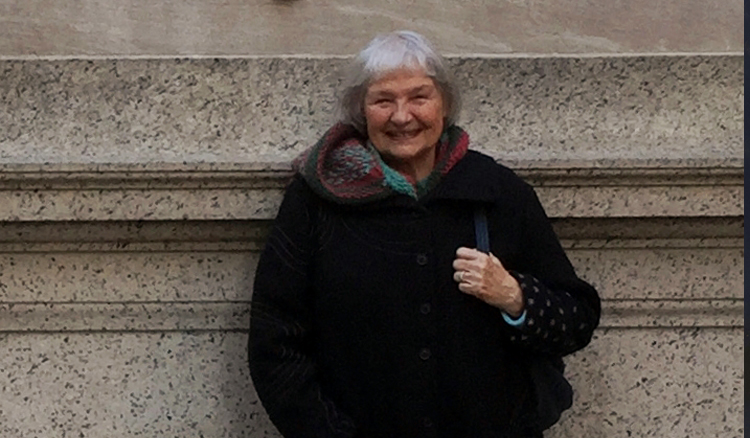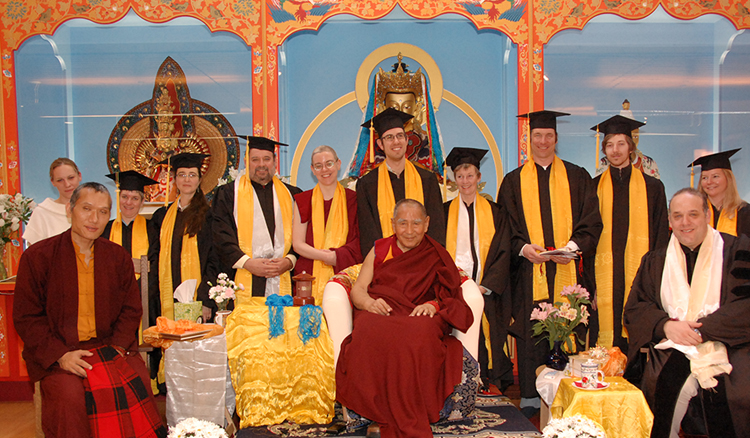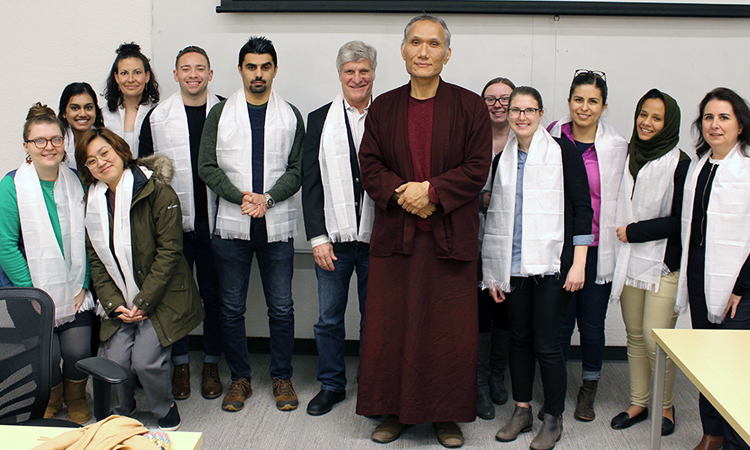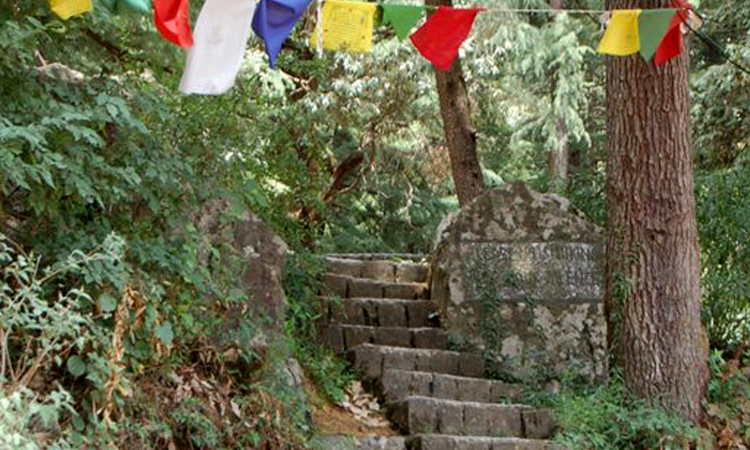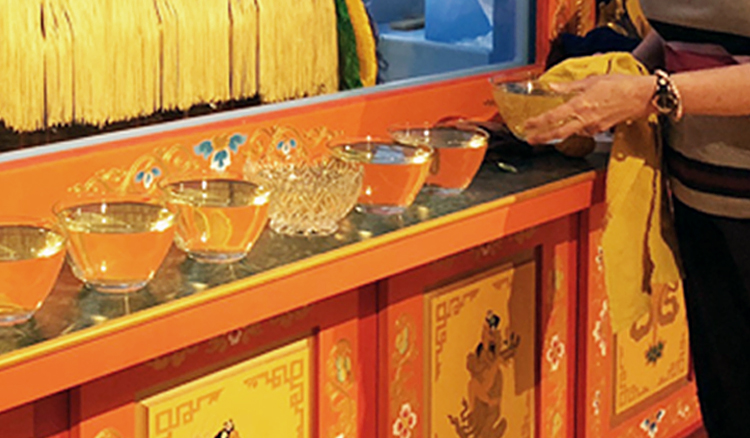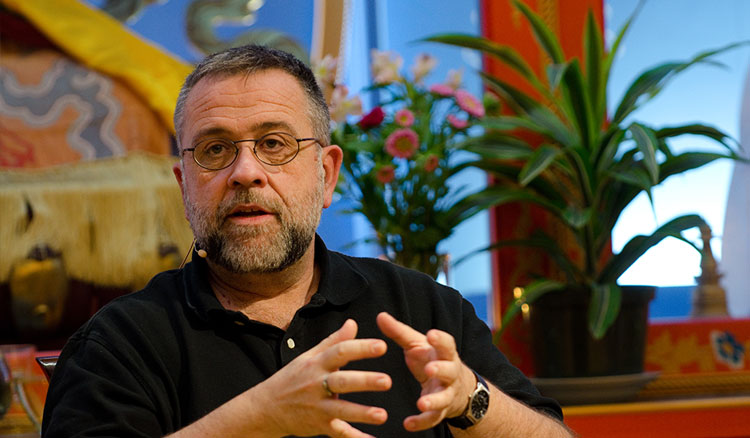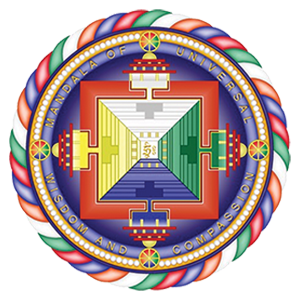by Leigh Miller, PhD, Director of Maitripa College Master of Divinity Degree Program
The first time I responded as a Chaplain to a Code Blue (when someone’s heart and/or breathing has stopped) in the Emergency Department of an urban hospital, I became the spiritual caregiver to a young man whose father was undergoing multiple rounds of chest compressions and cardiac arrest. The tall man, dressed from baseball hat to sneakers in all black, was angry, afraid, alone. He looked at me with trepidation, reliance, aggression, and despair.
Years of academic and administrative training and leadership prompted conditioned habits of competency: be informed, know what to do or find an authoritative source to rely on, have a plan or at least a clear goal for next steps of action… Panic arose as I realized I was fairly uninformed about how Emergency Departments operate, what the chaplain’s role is there, or how spiritual care in urgent moments of crisis and possible imminent death was “supposed to” look.
I stepped outside the room into a busy corridor and frantically started Google-ing, then trying to open an App I’d recently downloaded for chaplaincy resources, and then mentally scanning through past readings on pastoral care theory of anticipatory grief and hospital and spiritual care department orientation information…wasn’t there a freaking checklist someplace of minimal steps I should not fail to do in such situations?!?
After just a few minutes of this self-obsessed angst over how I was going to do the right thing or not, however, I stopped. Clearly, this behavior was futile in the circumstances (and I had already been entrusted to be there wearing the “Chaplain” badge, even if I didn’t yet feel I was prepared). Importantly, abandoning that approach allowed something else to arise in me: an embodied expression of dharma practice that is the foundation for my studies of spiritual care.
In that hallway, I acknowledged, What I am doing right now is not going to help anyone.
Instead, I was forced to consider: What did this terrified, loving son need, right now?
I walked back into that Emergency room, planted my feet on the earth, lengthened my spine toward the sky, feeling “Strong Back, Soft Front” (Roshi Joan Halifax). A couple of slow breaths along with the Medicine Buddha mantra followed. In just the brief space of a posture adjustment, a couple of breaths, and silent mantra, I was transformed: grounded and solid like a rock, spaciously open to hold whatever unknown events were going to transpire next, made fearless by compassion. My body and heart already knew how to do this, even if I wasn’t seated on a cushion.
It mattered for that son.
I believe my presence and accompaniment facilitated his ability to be present to his own love, compassion, and grief in those terrible hours, and for these to not be overshadowed by his initial strong states of fear and anger.
Over the following months in the hospital, I came to develop deepening trust in the cumulative effects of training in the Buddhist path. I was then and remain now surprised by every instance of its expression in my spiritual care work because it was as often intentional as it was spontaneous, subterranean, largely effortless, and not very much caught up in my usual sense of self. It felt like magic, but of course, it was completely logical.
There’s nothing special about me; like all of us, I practice a path that promises the natural, predictable unfolding of the results of refuge and the bodhisattva vow, the compass of the teachings steadily and constantly pointing towards compassion, equanimity, loving kindness, joy, and dependent arising. It is supposed to change us, but this can be hard to see in the day-to-day of our lives. I discovered that encounters with suffering gifted me with occasions to rely on the Dharma, and to allow myself to simply be with others and trust that what we co-created could be of life-affirming value and meaning.
It is true that in this work, we may never witness the outcomes of our time with seekers of spiritual care. We may know that moments of respite are but fleeting moments. And, even if we can momentarily bolster someone’s resilience in the face of grief, injustice, trauma, or addiction in the setting we share that day, we also know that all of us will continue to face a world of sickness, suffering, and loss, systemic racism, inequity, and violence, and we cannot remain by their sides. So how can we trust that our spiritual care is bringing about benefit for sentient beings?
It was an encounter with a patient I didn’t even initially like very much that profoundly shook loose my lingering doubts about what we could even hope to accomplish through this work, given the state of the world. Visits with patients in the hospital who were already inclined towards spirituality and introspection, or for whom the badge “Chaplain” pinned to my shirt predisposed them to vulnerability, confessions, and theological reflection, or who gushed with sincerity about how much our conversation had helped them were, if emotionally intense, relatively easy to hold with empathy and compassion, as well as inspiring and uplifting to reflect upon. With a few people, initial reticence about this white, female “chaplain” coming into their room blossomed into real connection, and long-restrained griefs and heartfelt aspirations about the preciousness of all life flowed forth.
But the visits which were hard for me certainly happened, too, triggering my own biases, resentments, anxieties, and defenses. Before entering a room, one has no idea which type of scenario could unfold. (Talk about training in no expectations, no attachment to outcomes, and ‘not knowing’ mind!) I reminded myself to walk slowly, more slowly, more mindfully, toward the door, aware of a light, loose motivation–to not harm, to not give up on anyone, to be of some benefit however slight–in my mind.
I heard the challenging patient well before setting eyes on him, his angry yelling interrupting my quiet pre-visit ritual walk up the hall. A nurse said, with exasperation as much as hopeful pleading, “good luck with that one.” For the next 35 minutes, the patient and I engaged in very subtle combat: he repeating a litany of complaints about the staff’s poor management of his chronic pain and the evils the heartless medical system perpetrated on everyone like him; me trying every therapeutic and contemplative intervention in the book. Nothing felt like it was “working”, and I found myself getting really annoyed at his broken record of stubborn negativity! As soon as I noticed that thought, I was abashed, and withdrew some of my attention from his speech and redirected it to my own internal experience. I observed that my shoulders were tight and hunched up, and I felt a familiar defensive sensation from my familial context of feeling the need to interrupt blame and frustration that I see being hurled at others. This patient, however, was not my kin, nor did I have to fix anything.
Then it occurred to me: nothing this man is expressing can actually harm me… there is no ‘me’ here to defend… no need for him to be any particular way….in fact, all that there is before me is simply a being in pain… that is all.
Spontaneously, a rush of natural compassion came up. My shoulders relaxed, my heart opened. It was only a moment, and I did not visibly move or say a word, so what happened next remains a kind of ‘sacred mystery.’ In some kind of interpsychic co-dependent arising, barriers around our hearts dissolved.
He paused, and then began to cry.
It had been unbearable, he revealed, to see his beloved but poor parents couch-bound by debilitating pain for the final years of their lives, he unable to do anything to help them. He was worried about his buddies, their bodies wrecked by manual labor. His Christian values deeply guided his actions, but he didn’t speak about them much, and accepted that others could take advantage of him if they knew of his willingness to refrain from harming others no matter the cost he might bear.
We named his advocacy, compassion, and faith, and voiced his heart’s longings as a prayer. After just five minutes or so, his tone quieted and softened, his expression was at ease, his body at rest in stillness. We said a peaceful good night. His physical and emotional pain would, doubtless, return. Yet, in those moments, he tasted freedom from suffering despite his pain. That imprint, like a fold in a sheet of paper, cannot be erased. Beyond any personal sense of self, I was astounded to realize that I mattered to the healing of the world.
Unless we try to strengthen the life in ourselves and others, as Dr. Rachel Naomi Remen terms it, how else is this world going to change?
“Healing” is perhaps a person-to-person, moment-by-moment emergent thing, not a cure or permanent state to attain, and it can happen in intimate spaces between relative strangers. From my perspective, it was my prior dharma practices of concentration and mindfulness, compassion, equanimity, and emptiness that gave rise to the kind self-awareness and other-awareness that created the conditions for the patient’s experience of healing that night.
As a chaplain, I feel that my bodhisattva vow is to not give up on anyone. In my practice and in walking down the hallways, I beseech the enlightened ones and my teachers for a lot of help to do this, to hold the view of people’s Buddha nature and limitless potential, especially when they, “the system”, and others could not or would not affirm their basic worth as living beings, and when healing, safety, trust, or change felt impossible.
In the hospital, I was doing good enough professional spiritual care learning to put into practice the skills and theories I had been taught, but I need Buddhist methods of compassion cultivation and philosophical analysis of phenomenon to make sense of how and why spiritual care is a powerful response to suffering. Years of exposure to essential Mahayana points have formed a nexus in my understanding and expression of them. Noticing that Buddhist concepts and qualities–such as awareness of the lack of inherently existing self, compassion, dependent arising, love, Buddha nature, the blessings of buddhas and teachers, and a bodily-sensed grounding, spaciousness, and fearlessness–can arise in me at all helps me see that Dharma is the foundation for my integration of contemporary spiritual care and social justice theories, critical self-reflexivity, and professional competency as a caregiver.
In other words, I believe contemplative training in spiritual practice is the heart of spiritual formation. May it be part of our journeys in preparation for chaplaincy, ministry, and caring for ourselves and others, to be what we are needed to be in this world.
For more on this topic, please visit this page of our website: https://maitripa.org/buddhist-chaplaincy/mdiv_paths-to-chaplaincy/spiritual-formation-foundations-for-chaplaincy/


